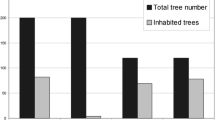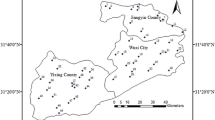Abstract
Road-based transport emissions are a major source of atmospheric metal pollution. However, there have been few studies on emissions from road traffic in mountainous areas. In this study, epiphytic mosses from trees at different elevations of a highway, a typical road with extraordinary elevation change in a mountainous area of karst in Guizhou, China, were analyzed for metal content as well as the spatial distribution pattern of metals. Mosses were sampled from three sections of highway at different elevations, from 1292–1357, 1394–1441, to 1481–1548 m. Principal component analysis and heat-map clustering were used to identify the principal factors affecting metal deposition. The results show that the metals of mosses from different elevations were divided into four factors. Group 1 which included Ni, Fe, Mg, Ba, and Al was attributed to a dominantly geogenic source. Group 2 included Zn, Cu, Mn, and Cr, from vehicle-related materials including tires and brakes. Group 3, Cd, can be attributed to high Cd background levels from local origins and traffic emissions, particularly tire wear. Group 4, Pb, is associated with brake wear and historical deposition. The epiphytic moss widely distributed in the study area, Ectropothecium aneitense Broth. & Watts, was used to analyze the spatial distribution pattern of the metals. Metal content gradually decreased with increase in elevation. Levels of Ni, Fe, Mn, Ba, and Cd were all significantly correlated with elevation (p < 0.05), simultaneously affected by terrain and vertically stratified. We highlighted the vertical distribution characteristics of metal in epiphytic mosses in this study, which could improve moss application for ecological monitoring due to road-based transport emissions with elevation changes.




Similar content being viewed by others
References
Allen JO, Mayo PR, Hughes LS, Salmon LG, Cass GR (2001) Emissions of size-segregated aerosols from on-road vehicles in the Caldecott tunnel. Environ Sci Technol 35:4189–4197
Ai JC, Wang N, Yang J (2014) Source apportionment of soil heavy metals in Jiapigou goldmine based on the UNMIX model. Environ Sci 35:3530–3536
Barałkiewicz D, Siepak J (1999) Chromium, nickel and cobalt in environmental samples and existing legal norms. Pol J Environ Stud 8:201–208
Bates JW (2000) Mineral nutrition , substratum ecology, and pollution. In: Shaw A J, Goffinet B, eds. Bryophyte biology. Cambridge: Cambridge University Press pp.248–311;403–448
Bukowiecki N, Lienemann P, Figi R, Hill M, Richard A, Furger M, Rickers K, Cliff SS, Baltensperger U, Gehrig R (2009) Emission factors and source apportionment for abrasion particles produced by road traffic. Geophys Res Abstr 11:2009–2945
Chakrabortty S, Govind T, Paratkar (2006) Biomonitoring of trace element air pollution using mosses. Aerosol Air Qual Res 6:247–258
Cincinelli A, Mandorlo S, Dickhut RM, Lepri L (2003) Particulate organic compounds in the atmosphere surrounding an industrialised area of Prato (Italy). Atmos Environ 37:3125–3133
Costabile F, Paciucci L, Allegrini I (2005) Assessment and management of urban air pollution: a new project in Shanghai. Trans Built Environ 77:467–477
Donovan GH, Jovan SE, Gatziolis D, Burstyn I, Michael YL, Monleon VJ (2016) Using an epiphytic moss to identify previously unknown sources of atmospheric cadmium pollution. Sci Total Environ 559:84–93
Eldridge DJ, Tozer ME (1997) Environmental factors relating to the distribution of terricolous bryophytes and lichens in semi-arid Eastern Australia. Bryologist 100:28–39
Folkeson L (1979) Interspecies calibration of heavy-metal concentrations in nine mosses and lichens:-applicability to deposition measurements. Water Air Soil Pollut 11:253–260
Fritz Ö, Niklasson M, Churski M (2009) Tree age is a key factor for the conservation of epiphytic lichens and bryophytes in beech forests. Appl Veg Sci 12:93–106
Gao Q (1996) Flora bryophytarum sinicorum Vol. 2. Science Press, Beijing, pp 54–257
Garg BD, Cadle SH, Mulawa PA, Groblicki PJ, Laroo C, Parr GA (2017) Brake wear particulate matter emissions. Environ Sci Technol 34:4463–4469
Genuino HC, Opembe NN, Njagi EC, Mcclain S, Suib SL (2012) A review of hydrofluoric acid and its use in the car wash industry. J Ind Eng Chem 18:1529–1539
Germann K. (1973) Deposition of manganese and iron carbonates and silicates in liassic marls of the Northern Limestone Alps (Kalkalpen) Ores in Sediments. Springer Berlin Heidelberg, 1973:129–138
Gunawardena J, Egodawatta P, Ayoko GA, Goonetilleke A (2012) Role of traffic in atmospheric accumulation of heavy metals and polycyclic aromatic hydrocarbons. Atmos Environ 54:502–510
Guo G, Lei M, Chen T, Song B, Li X (2008) Effect of road traffic on heavy metals in road dusts and roadsides oils. Acta Sci Circumst 28:1937–1945
Guo S, Yu J, Chen G (2015) Ecological data analyses. Science Press, Beijing, pp 21–157
Hjortenkrans D, Bo B, Häggerud A (2006) New metal emission patterns in road traffic environments. Environ Monit Assess 117:85–96
Hjortenkrans DST, Bergbäck BG, Häggerud AV (2007) Metal emissions from brake linings and tires: case studies of Stockholm, Sweden 1995/1998 and 2005. Environ Sci Technol 41:5224–5230
Hu R, Wang Y (2005) Flora bryophytarum sinicorum Vol.7 Science Press, Beijing. pp. 12-254
Jeran Z, Jaćimović R (2001) Radionuclides and heavy metals in environment. In: The use of lichens and mosses to monitor trace element pollution in Slovenia. Springer, Netherlands, pp 11–115
Jiang D, Huang J (2017) Analysis and contents determination of heavy metals in platycodon grandiflorus at different altitudes in the Three Gorges Reservoir Area. China Pharmacy 28:1687–1691
Karanasiou A (2014) Road dust emission sources and assessment of street washing effect. Aerosol Air Qual Res 14:734–743
Keiloun M, Yang F, Chau YK, Gagnon F, Bouyahi B, Rivard M, Kennedy G, Normandin L, Zayed J (2002) Exposure of gas station attendants to methylcyclopentadienyl manganese tricarbonyl (MMT) used in gasoline. Water Air Soil Pollut 141:155–163
Laidlaw MAS, Filippelli GM (2008) Resuspension of urban soils as a persistent source of lead poisoning in children: a review and new directions. Appl Geochem 23:2021–2039
Lawrence S, Sokhi R, Ravindra K, Mao H, Prain HD, Bull ID (2013) Source apportionment of traffic emissions of particulate matter using tunnel measurements. Atmos Environ 77:548–557
Legittimo PC, Benvenuti R (1996) Heavy metals in epiphytic mosses: an experience in Florence. Chem Ecol 13:39–49
Li D, Tang Y, Chen K, Liu D, Cheng F, Deng T (2005) Mineralogy and its geological origin of the K6 coal seam from the Qinglong coalfield, Guizhou Province. J China Coal Soc 30:49–52
Li X (2006) Flora bryophytarum sinicorum vol.4. Science Press, Beijing. pp.24–358
Liu HJ, Wang JG, Xia Y, Yang MJ, Liu SW, Zhao LC, Guo XP, Jiang YJ, Li X, Wu QF (2017) Elemental compositions of lichens from Duolun County, Inner Mongolia, China: origin, road effect and species difference. Sci Rep 7:5598
Marchesini M, Pagano R (2001) The Val Graveglia manganese district, Liguria, Italy. Mineralogical Record 32:349–415
Miller FJ (2000) Dosimetry of particles in laboratory animals and humans in relationship to issues surrounding lung overload and human health risk assessment: a critical review. Inhal Toxicol 12:19–57
Mitchell RJ, Sutton MA, Truscott AM, Leith ID, Cape JN, Pitcairn CER, Dijk NV (2004) Growth and tissue nitrogen of epiphytic Atlantic bryophytes: effects of increased and decreased atmospheric N deposition. Funct Ecol 18:322–329
Mudd JB, Kozlowski TT (1976) Responses of plants to air pollution. Q Rev Biol 78:1940–1941
Murata K, Kano O, Iwamoto K, Ikeda K, Iwasaki Y (2011) Air pollution from traffic emissions in Oporto, Portugal: health and environmental implications. Microchem J 99:51–59
Naszradi T, Badacsonyi A, Németh N, Tuba Z, Franc B (2004) Zinc, lead and cadmium content in meadow plants and mosses along the M3 Motorway (Hungary). Journal of Atmospheric Chemistry. 49. 593-603
Niemelä M, Piispanen J, Poikolainen J, Perämäki P (2007) Preliminary study of the use of terrestrial moss (Pleurozium schreberi) for biomonitoring traffic-related Pt and Rh deposition. Arch Environ Contam Toxicol 52:347–354
Oludare A, Olayinka H, Nwanya OOA (2014) Soil and water pollution levels in and around urban scrapyards. IOSR J Environ Sci Toxicol Food Technol 8:2319–2399
Rao DN (1982) Responses of bryophytes to air pollution. Bryophyte ecology. Springer Netherlands
Réquia WJ, Koutrakis P, Roig HL, Adams MD (2016) Spatio-temporal analysis of traffic emissions in over five thousand municipal districts in Brazil. J Air Waste Manage Assoc 66:1284–1293. https://doi.org/10.1080/10962247.2016.1221367
Ruth U, Barbante C, Bigler M, Elmonte BD, Fischer H, Gabrielli P, Gaspari V, Kaufmann P, Lambert F, Maggi V (2008) Proxies and measurement techniques for mineral dust in Antarctic ice cores. Environ Sci Technol 42:5675–5681
Sedia EG, Ehrenfeld JG (2005) Differential effects of lichens, mosses and grasses on respiration and nitrogen mineralization in soils of the New Jersey Pinelands. Oecologia 144:137–147
Shapiro SS, Wilk MB (1965) An analysis of variance test for normality (complete samples). Biometrika 52:591–611
Spagnuolo V, Terracciano S, Giordano S (2009) Trace element content and molecular biodiversity in the epiphytic moss Leptodon smithii: two independent tracers of human disturbance. Chemosphere 74:1158–1164
Sternbeck J, Sjödin Å, Andréasson K (2002) Metal emissions from road traffic and the influence of resuspension—results from two tunnel studies. Atmos Environ 36:4735–4744
Strother SC, Anderson JR, Schaper K.A, Sidtis JJ, Liow JS, Woods RP, Rottenberg DA (1995) Principal component analysis and the scaled subprofile model compared to intersubject averaging and statistical parametric mapping: I. “functional connectivity” of the human motor system studied with [15O] water PET. J Cerebral Blood Flow Metab Off Cereb Blood Flow Metab 15(5):738–753
Świetlik R, Strzelecka M, Trojanowska M (2013) Evaluation of traffic-related heavy metals emissions using noise barrier road dust analysis. Pol J Environ Stud 22:561–567
Thöni L, Yurukova L, Bergamini A, Ilyin I, Matthaei D (2011) Temporal trends and spatial patterns of heavy metal concentrations in mosses in Bulgaria and Switzerland: 1990–2005. Atmos Environ 45:1899–1912
Thomas W (1984) Statistical models for the accumulation of PAH, chlorinated hydrocarbons and trace metals in epiphytic Hypnum cupressiforme. Water Air Soil Pollut 22:351–371
Thorpe A, Harrison RM (2008) Sources and properties of non-exhaust particulate matter from road traffic: a review. Sci Total Environ 400:270–282
Thorpe AJ, Harrison RM, Boulter PG, Mccrae IS (2007) Estimation of particle resuspension source strength on a major London Road. Atmos Environ 41:8007–8020
Wang RJ, Wang K, Zhang F (2017) Emission characteristics of vehicles from national roads and provincial roads in China. J Environ Sci 38:3553–3560
Westerlund K (2001) Metal emissions from stockholm traffic - wear of brake linings. SLB-ANALYS 3:1–10
Wu P (2002) Flora bryophytarum sinicorum vol. 6. Science Press, Beijing, pp. 167-265
Wu P (2011) Flora bryophytarum sinicorum vol. 5. Science Press, Beijing, pp. 2-109
Wu P, Jia Y (2004) Flora bryophytarum sinicorum vol. 8. Science Press, Beijing, pp. 5-261
Wu X (2012) The heavy metal pollution analysis of the urban surface soil. Electron Technol 39:31–33
Zayed J (2001) Use of MMT in Canadian gasoline: health and environment issues. Am J Ind Med 39:426–433
Zhou D (2007) A preliminary study on the development model of agricultural products processing industry in Qinglong county. Group Econ Res 9Z:61–62
Acknowledgements
We thank Alison Downing and Brian Gulson for constructive comments and advice on the text. We also thank Huihui Wang, Zheke Li, and Wei Wang for our help with fieldwork.
Funding
This work was supported by the National Nature Science Foundation of China (NSFC; No. 31360043, No. 31760043, and No. 31760050).
Author information
Authors and Affiliations
Corresponding author
Additional information
Responsible editor: Philippe Garrigues
Rights and permissions
About this article
Cite this article
Liu, R., Zhang, Z., Shen, J. et al. Analysis of metal content and vertical stratification of epiphytic mosses along a Karst Mountain highway. Environ Sci Pollut Res 25, 29605–29613 (2018). https://doi.org/10.1007/s11356-018-2883-4
Received:
Accepted:
Published:
Issue Date:
DOI: https://doi.org/10.1007/s11356-018-2883-4




